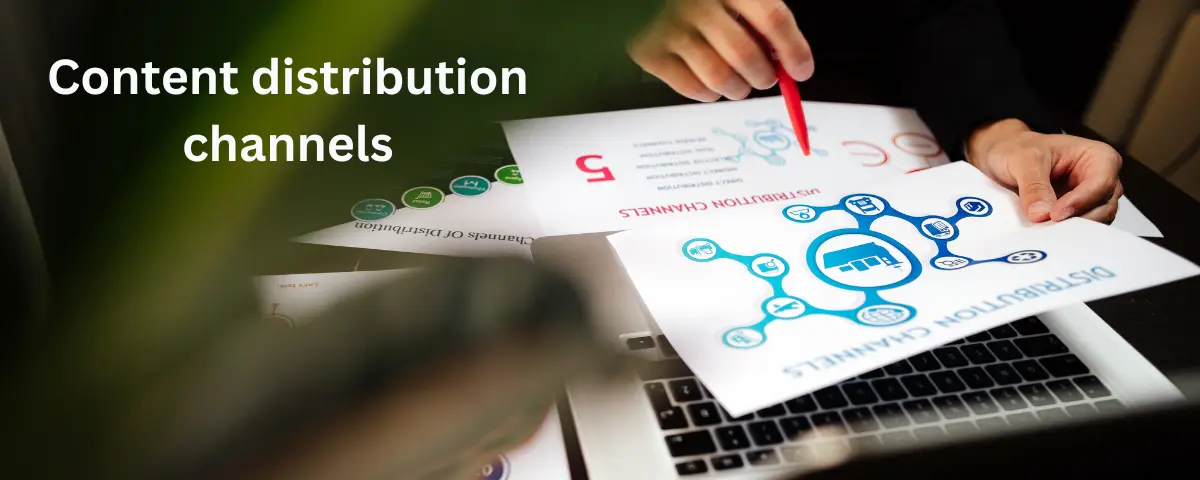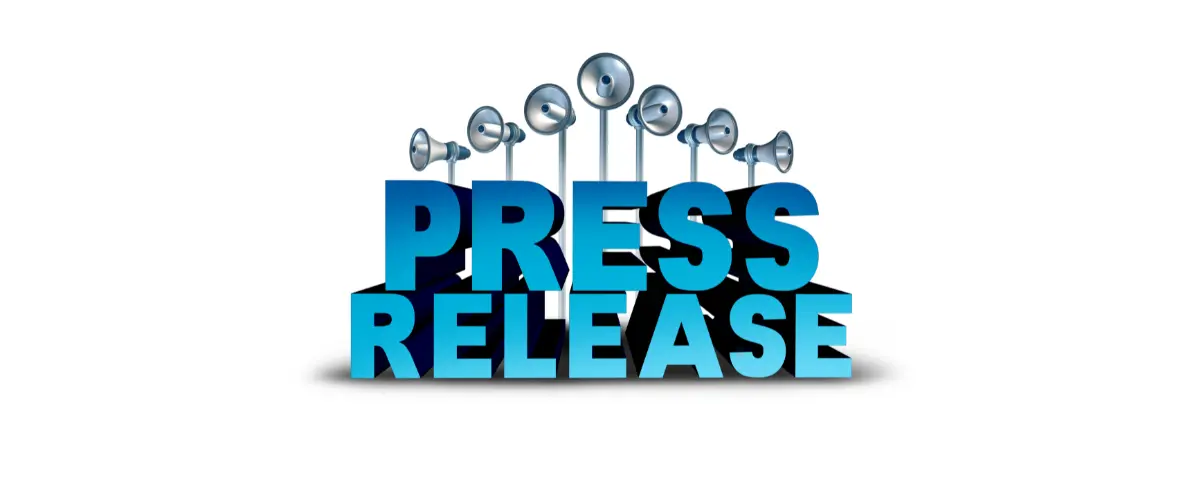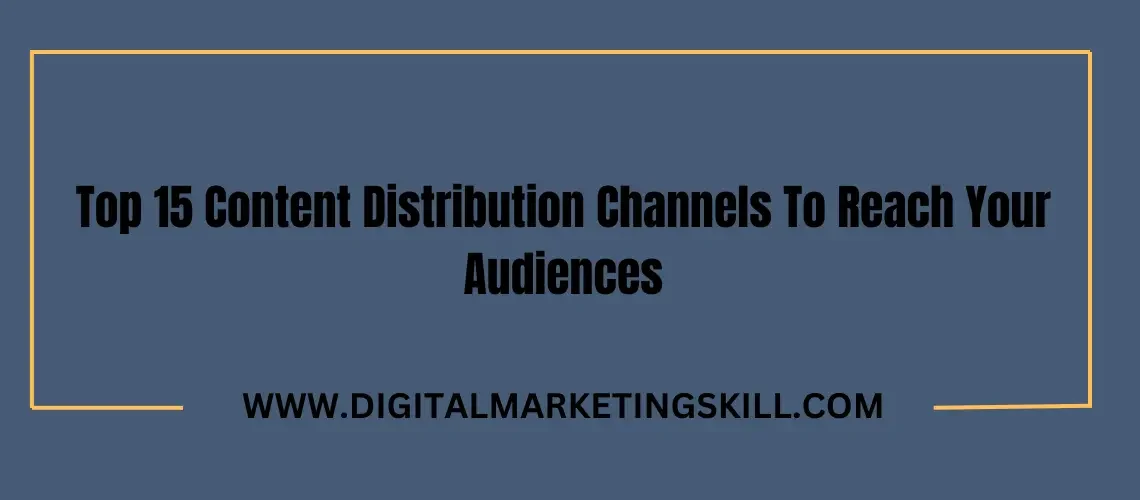Are you struggling to reach your target audience with your content? Do you find it challenging to identify the most effective content distribution channels?
Look no further! In this article, we will explore different content distribution channels that can help you reach your audiences and maximize engagement. From social media platforms to email newsletters, we will discuss each of the channels and provide insights on how to leverage them effectively.
By the end of this article, you will have a comprehensive understanding of the best content distribution channels to reach your audiences and achieve your marketing goals.
What is content distribution?
Content distribution is a strategic process of disseminating and promoting content across various channels and platforms to reach a wider audience effectively. It involves sharing different types of content using different channels and more to engage with target audiences and maximize visibility.
Importance of Content Distribution
Content distribution is crucial for ensuring that high-quality content reaches the intended target audience and resonates effectively. Without a robust distribution strategy, even the best content may go unnoticed. It helps in increasing brand awareness, engagement, lead generation, and sales conversion by reaching the right audience through the right channels at the right time
Types of Content Distribution Channels
1. Owned Channels: These are platforms controlled by the organization, such as websites, blogs, social media profiles, newsletters, and mobile apps.
2. Earned Channels: External third-party platforms where content about the brand is shared, including mentions, shares, backlinks, blog features, and media coverage.
3. Paid Channels: Platforms where content distribution is promoted through paid efforts like paid ads, social media ads, sponsored content, and influencer collaborations.
Types of Content That Can Be Distributed
Get 50% Discount to Master ALL Aspects of Digital Marketing That Can Earn You $2,500 - $5,000 a month (Even if you are a complete beginner!)
Our students that intentionally implement what they learn from our digital marketing course make back the entire course fee within a single month or more after completing our course because our course gives them many income generating options with unlimited earning potential with no age or location barrier. The best part is no technical skills are required.
An opportunity to change your lifestyle and make money working from anywhere in the world. The results our students get from our digital marketing course prove this could be applied to any market or country and that it is designed for any skill level and work background.
*By signing up, you agree to our privacy policy and terms of service.
Various types of content can be distributed to reach and engage your target audience effectively include:
- Blog Posts
- Videos
- Infographics
- Ebooks/Guides
- Case Studies
- Podcasts/Audio Content
- Social Media Posts
- Webinars/Online
- Events
- Email Newsletters
- Whitepapers
- Interactive Content
- User-Generated Content
20 Content distribution channels

Content distribution channels are essential avenues through which content is shared and promoted to reach a wider audience effectively. These channels play a crucial role in boosting brand awareness, engaging followers, passing information and driving conversions. They Include:
1. Website Content
Website content is those text, images, videos, and other multimedia elements displayed on a website. It plays a crucial role in conveying information, engaging visitors, and driving desired actions.
A well-crafted website content is essential for communicating the brand’s message, showcasing products or services, and providing valuable resources to users.
From informative blog posts to compelling product descriptions, website content aims to educate, entertain, and persuade visitors to explore further and take desired actions.
When you create relevant, high-quality content that resonates with the target audience, businesses can enhance their online presence, and achieve their marketing objectives effectively.
2. Blog
Blogs serve as a fundamental content distribution channel where individuals and businesses can publish articles, insights, and updates about their brands to their audience.
When you regularly post valuable and engaging content on a blog, it can attract more readers, drive traffic to your website, and establish your brand as an industry expert.
Blogs offer a platform for storytelling, and an opportunity to discuss particular topics that solve audience pain points and foster connections with readers. Through search engine optimization (SEO) strategies, blogs can reach a wider audience and improve online visibility for your content to be seen online.
3. Social Media
Social media is online platforms that enable users to create, share, and interact with content in real-time. These platforms facilitate communication, networking, and content sharing among individuals and businesses worldwide with their audience.
Popular social media platforms like Facebook, Instagram, Twitter, LinkedIn, and TikTok offer diverse features such as posting updates, sharing photos and videos, engaging with followers through comments and sharing the latest information on what they need to know.
Social media plays a vital role in connecting your brand with the right people, promoting what the brand is about, and driving engagement. You can learn how to create content for business by enrolling in some or all of the courses listed to engage your audience.
4. Email Newsletter

Email newsletters provide a direct line of communication, enabling you to engage with subscribers, drive traffic to your websites, and nurture relationships over time.
When you send regular newsletters, you can share updates, promotions, and valuable information with your audience in a personalized and targeted manner. Email newsletters allow you to deliver curated content directly to subscribers’ inboxes.
Email newsletters can enhance brand loyalty, increase conversions, and drive engagement by creating an effective design, compelling copywriting, and segmentation strategies.
You can use email newsletters as a channel to stay connected with your audience, deliver relevant content, and achieve their marketing objectives efficiently.
5. Social media groups
Social media groups enable businesses and individuals to reach a targeted audience and engage in meaningful conversations.
When you share content within relevant social media groups, users can leverage the group’s community to increase visibility, drive engagement, and foster relationships.
Social media groups also give you access to receive feedback, collaborate with others in their industry or niche and engage with your audience.
By strategically participating in and contributing to social media groups, businesses can enhance their online presence, establish thought leadership, and ultimately achieve their marketing objectives effectively.
6. Video
Video allows individuals and businesses to share engaging and visually compelling content with their audience. Through videos, you can convey information, tell stories, showcase products, or provide tutorials in a dynamic and interactive format.
Videos can capture attention, evoke emotions, and deliver messages effectively, making them a popular choice for content distribution.
Platforms like YouTube, Vimeo, and social media channels offer opportunities to reach a wide audience through video content.
So when you have a marketing plan, make sure you incorporate videos into the content strategy. This can enhance your engagement, increase brand visibility, and connect with your audience on a more personal level.
7. Bloggers/Influencer Outreach

Blogger/Influencer outreach involves collaborating with influential bloggers or social media personalities to share and promote content.
When you use bloggers and influencers with a large and engaged following, businesses and individuals can tap into their audience and expand their reach.
This approach allows for the sharing of content with a targeted and receptive audience, potentially leading to increased engagement, brand awareness, and conversions.
Blogger/Influencer outreach requires building genuine relationships with influencers, providing valuable content, and fostering a mutually beneficial partnership.
When you take advantage of the power of influencers, businesses can effectively distribute their content, reach new audiences, and achieve their marketing objectives.
8. Quora
Quora is a valuable content distribution channel where individuals and businesses can share their content with a targeted audience.
This platform allows users to answer questions, provide insights, and share knowledge, positioning them as thought leaders in their respective fields.
Adding Quora as a distribution channel where you share your information to reach receptive audiences actively seeking answers to a topic, you can win their trust and be their go-to brand.
This helps to drive more traffic to your websites or blogs through content sharing and connecting with more followers.
Participating in Quora discussions and sharing valuable content can enhance your online presence and build credibility within the platform’s diverse user base.
9. Podcasting
Podcasting allows individuals and businesses to create audio content on various topics for listeners to access on-demand.
Podcasts offer a convenient way for audiences to consume information, entertainment, and insights while multitasking or on the go. When you produce engaging podcast episodes, you can reach a wide audience, build a loyal following, and establish authority in your niche.
Popular podcasting platforms like Apple Podcasts, Spotify, and Google Podcasts provide opportunities for content distribution, enabling businesses to share their message, connect with listeners, and drive engagement effectively.
Leveraging podcasting as a distribution channel offers a unique avenue to connect with audiences through storytelling, interviews, and valuable content delivery.
10. Guest Posting
Guest posting is a strategy where you create and publish articles on external websites or blogs within their industry or niche.
When you contribute high-quality content to reputable platforms, you can reach a new audience, drive traffic back to your website, and enhance your online visibility.
Guest posting allows for building credibility, establishing thought leadership, and expanding reach by tapping into the existing readership of the hosting site.
This distribution strategy not only benefits the host site with fresh content but also provides valuable exposure and backlinks opportunities for the guest contributor. This ultimately helps to grow your audience and authority in the industry.
11. Press Releases

Press releases are a traditional yet effective content distribution channel used by businesses to share newsworthy information with the media, industry publications, and the public.
These official statements provide journalists and news outlets with key details about company announcements, product launches, events, or significant developments.
By using press releases to distribute your content, businesses can generate media coverage, increase brand visibility, and attract attention from journalists and potential customers.
Press releases serve as a valuable tool for building credibility, shaping public perception, and disseminating important updates to a wide audience.
Using press releases as a disseminate information can help businesses amplify their message and establish a strong presence in the market.
12. Online Platforms
Online platforms serve as a means for sharing content with a wide audience in digital technology. These platforms encompass websites, social media networks, blogging sites, and content-sharing platforms where individuals and businesses can publish and promote their content.
Online platforms like Medium and HARO (Help a Reporter Out) serve as valuable distribution channels for content creators to share their work and expertise with a broader audience.
Medium is a popular blogging platform that allows writers to publish articles on various topics, reaching a large community of readers and potential followers. On the other hand, HARO connects journalists with expert sources for news stories, providing an opportunity for individuals to contribute insights and commentary in their respective fields.
These online platforms enable you to showcase your content, establish authority, and connect with readers or journalists seeking valuable information and perspectives.
13. Webinar
A webinar allows individuals and businesses to host live or pre-recorded online seminars, workshops, or presentations to a targeted audience.
Webinars provide a platform for sharing valuable information, engaging with participants in real time, and showcasing expertise on specific topics.
When you host webinars, you can interact with attendees through Q&A sessions, polls, and discussions, fostering engagement and building relationships.
Platforms like Zoom, and Meet offer tools for hosting and managing webinars effectively. You get to deliver educational content, discuss relevant topics, and establish thought leadership in your industry through interactive and engaging online events.
14. Online Communities
Communities serve as valuable distribution channels for sharing content with a targeted audience and fostering engagement.
These communities can be online forums, social media groups, industry-specific networks, or local meetups where individuals with common interests gather to discuss topics, share insights, and connect with like-minded individuals.
Try to actively participate in communities related to their niche or industry, this can help build credibility and establish relationships within the community. This can help you to connect your content with those who need it, and receive feedback.
This can ultimately enhance your online presence and expand your reach effectively in a community-driven environment.
15. Collaborations
Collaborations are strategic ways where individuals or businesses partner with others to create and share content mutually.
When you collaborate with influencers, brands, or other creators, businesses can tap into new audiences, leverage each other’s expertise, and expand their reach effectively.
Collaborations can take various forms, such as co-created content, joint campaigns, guest posts, or social media takeovers. These partnerships offer opportunities to cross-promote content, share resources, and benefit from each other’s audience and credibility.
When you collaborate to distribute your content through other people’s channels, it helps you to amplify your message, build relationships, and achieve mutual marketing objectives through shared efforts and synergies in the competitive space.
16. Youtube

YouTube is a powerful content distribution channel that allows individuals and businesses to share video content with a global audience.
As the second largest search engine after Google, YouTube offers a platform for you to reach millions of viewers, build a subscriber base, and monetize your content.
When you create engaging videos, optimise titles and descriptions, and utilise tags and thumbnails effectively, it can enhance your visibility and attract viewers to your channel.
YouTube provides analytics tools to track your content performance, engage with viewers through comments, and collaborate with other creators.
YouTube helps you to showcase your content, establish authority in your niche, and connect with audiences through the engaging medium of video.
17. Niche Forums
Niche forums are specialized online communities where individuals with shared interests or expertise gather to discuss specific topics, seek advice, and share information.
These forums provide an opportunity to engage with a focused audience interested in a particular niche.
When you participate in niche forums related to their industry or your area of expertise, you can share your content, receive feedback, and establish credibility within the community.
Niche forums offer a platform for networking, knowledge-sharing, and building relationships with like-minded individuals.
Using niche forums as a distribution channel enables you to reach a receptive audience, drive engagement, and enhance their online presence effectively within a community tailored to their specific interests.
18. Paid Social Ads
Paid social ads are a strategic content distribution channel where businesses pay to promote their content on social media platforms to reach a targeted audience.
These ads appear in users’ feeds, timelines, or as sponsored posts, allowing businesses to increase visibility, drive traffic, and generate leads.
By leveraging paid social ads, businesses can target specific demographics, interests, and behaviors to ensure their content reaches the right audience effectively.
Platforms like Facebook Ads, Instagram Ads, LinkedIn Ads, and Twitter Ads offer robust targeting options and analytics to track performance, optimize campaigns, and achieve marketing objectives.
Paid social ads provide a cost-effective way to amplify content, enhance brand awareness, and drive conversions for your business.
19. Pay-per-click (PPC) advertising
PPC Ads is a digital marketing strategy where advertisers pay a fee each time their ad is clicked. This model allows businesses to display ads on search engines or websites and target specific keywords or demographics.
PPC ads appear at the top of search engine results or on relevant websites, driving traffic to the advertiser’s website.
Platforms like Google Ads and Bing Ads offer robust tools for creating and managing PPC campaigns, including keyword research, ad copywriting, and performance tracking.
When you utilize PPC advertising as a distribution channel, businesses can attract qualified leads, and achieve specific marketing goals through targeted and measurable campaigns based on the business goal.
20. Paid influencer marketing
Paid influencer marketing is where businesses partner with social media influencers to promote their products, services, or content.
In this approach, influencers create and share sponsored content with their followers, leveraging their influence and reach to drive engagement and conversions.
Paid influencer marketing offers several benefits, including access to a targeted audience, increased brand visibility, and credibility through association with a trusted influencer.
Platforms like Instagram, YouTube, and TikTok provide opportunities for businesses to connect with influencers and create sponsored content campaigns that align with their marketing objectives.
To learn more on how to create various content for different channels for your business, hone your skills with digital marketing skills by enrolling in some or all of the courses to get started.
Bottom Line
Content distribution channels play a crucial role in reaching and engaging audiences effectively. when you strategically utilise owned, earned, and paid media channels, you can share your content with the right audience at the right time. Owned media channels like websites and social media offer control and simplicity, while shared media like social platforms provide vast reach. Paid media, including social ads, ensures targeted exposure. Choosing the right mix of distribution channels is essential for boosting brand awareness, driving conversions, and maximizing engagement. Remember, while creating great content is important, distributing it effectively through various channels is key to expanding reach and connecting with target audience.
FAQs
What are content distribution strategies?
Content distribution strategies are systematic plans outlining how to disseminate and promote content effectively to reach a target audience. These strategies encompass various tactics, platforms, and channels, ensuring that content reaches the intended recipients, maximizes engagement, and achieves desired objectives.
What are the methods of content distribution?
Content can be distributed through three main methods or “channels”: owned media (e.g., websites, email newsletters), earned media (e.g., press mentions, guest articles), and paid media (e.g., pay-per-click advertising, sponsored posts). Each method offers unique advantages in reaching and engaging audiences effectively.
How do you create a content distribution?
Creating content distribution involves developing a well-defined strategy that includes audience identification, content types, distribution channel selection, promotion tactics, scheduling, measurement of key performance indicators (KPIs), and optimization based on data analysis. This process ensures that content resonates with the target audience and achieves desired outcomes.
How do you create a content distribution plan?
To create a content distribution plan, follow these steps:
- Identify your target audience and their preferences.
- Determine the types of content to distribute.
- Select appropriate distribution channels (owned, earned, paid media).
- Develop a promotion strategy using tactics like social media marketing and SEO.
- Establish a schedule for content distribution.
- Monitor KPIs to evaluate effectiveness.
- Optimize the plan based on data analysis for improved reach and engagement.
More Resources
Convert Your Leads: Step-by-step Content Marketing Tactics for Your Brand
10 Vital Questions to ask your Clients on content marketing
Lead Generation Strategy: Get leads With This 7 Content Strategies


